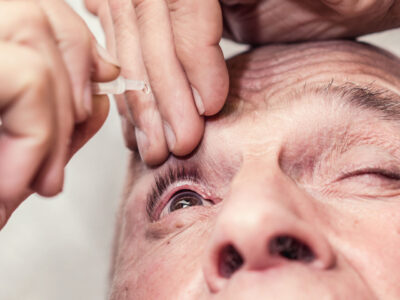The thought of losing your vision is frightening. Your eyes are the primary way you take in the world, so you should take seriously any threat to your ability to see.
Often called “the silent blinder” or “the silent thief,” untreated glaucoma is one of the leading causes of blindness. Its onset can be gradual or rapid, but it usually doesn’t present with symptoms until it’s too late to stop the damage from occurring.
While there is no lasting cure for glaucoma, early detection and treatment can go a long way toward delaying the condition’s effects and preserving your eyesight.

What Is Glaucoma?
Glaucoma refers to several conditions, all caused by damage to the optic nerve. While the exact cause of the damage is unknown, the most common form of the disease is marked by increased pressure inside the eyeball. Usually, this increase in pressure is due to damage or blockage of the eye’s drainage system.
Your eye creates a fluid called “aqueous humor,” which serves multiple purposes in the eye, including supporting your cornea and providing lubrication. This fluid is constantly being created in the eye, and old fluid is drained and carried away from the eye by the bloodstream. If old fluid can’t drain properly, the pressure in the eyeball increases, potentially leading to nerve damage.
Other, less common types of glaucoma aren’t associated with high ocular pressure, and some types have a much faster onset and progression than the more common types.
How Is Glaucoma Diagnosed?
In checking for glaucoma, eye doctors perform a number of tests to assess glaucoma risk factors and the health of the optic nerve:
- Eye pressure check: After numbing the eye with special drops, a tiny instrument contacts the surface of the eye and determines the ocular pressure.
- Visual field test: This vision test will determine whether or not you’ve already begun to lose vision due to glaucoma.
- Imaging tests: After dilating your pupils, the doctor will use a special camera to take high-resolution photos of your retina and optic nerve and visually inspect for damage.
- Direct observation: While your eyes are dilated, the doctor will also use a special scope to view your retina and optic nerve directly.
- Pachymetry: This is a painless test that measures the thickness of your cornea. Thicker-than-normal corneas can lead to falsely-elevated pressure readings, while thinner-than-normal corneas are a glaucoma risk factor.
- Gonioscopy: A special contact lens will be placed on your eye to allow the doctor to see the areas of the eye where aqueous humor should be draining away.
Following all of these tests, the doctor can make an assessment and, if risk factors or symptoms are noted, begin setting up a treatment plan to help reduce the effects of glaucoma and preserve your vision.
What Are Some Other Glaucoma Risk Factors?
In addition to increased ocular pressure and lower corneal thickness, there are certain race- and age-related risk factors for glaucoma:
- African Americans over the age of 40 are at increased risk for glaucoma.
- All people over the age of 60, especially Hispanic/Latino individuals, have a higher risk.
- If a family member, especially a sibling, has glaucoma, you’re more likely to develop the disease.
Everyone should have regular eye exams to monitor eye health, and those in the higher risk categories above should get a comprehensive dilated eye exam at least once every 1-2 years.
What Are the Effects of Untreated Glaucoma?
In most cases, glaucoma will develop gradually over time. The irreversible nerve damage is already underway by the time the first symptoms appear.
The first symptom most patients notice is a slow loss of peripheral (side) vision. Sometimes called “tunnel vision,” this usually is a darkening or blurring around the edges of one’s field of vision. In many cases, the loss of peripheral vision is worse in the corners of the eyes closest to the nose. This usually happens so slowly that it doesn’t become noticeable until significant damage occurs.
If allowed to continue its progression, the peripheral blindness will eventually expand until the optic nerve stops functioning altogether, rendering the patient completely and irreversibly blind.
What Treatments Are Available For Glaucoma?
There is no known cure for glaucoma, but if it’s detected and treated early enough, you may be able to retain most or all of your eyesight for the remainder of your life. Treatment options include:
- Medicines: Most commonly, these take the form of eye drops that lower the ocular pressure, helping prevent future damage to the optic nerve.
- Laser treatment: If drops fail to reduce your eye pressure, doctors may be able to use lasers to clear out blockages in your eye’s drainage system. This is usually a simple procedure that can take place in the doctor’s office.
- Surgery: If neither drops nor laser therapy effectively lowers your eye pressure, doctors may elect to perform surgery. Surgical options may involve cleaning and opening the eye’s natural drain mechanisms or installing a shunt to drain fluid.
Regular Eye Exams Are the Best Way to Avoid Glaucoma-related Loss of Vision. Call Eyesight Associates and Schedule Your Exam Today!
Our eye care specialists have experience identifying those at high risk for glaucoma and helping them keep their eyesight. Give us a call to learn more: 478-923-5872.
Related Articles:
